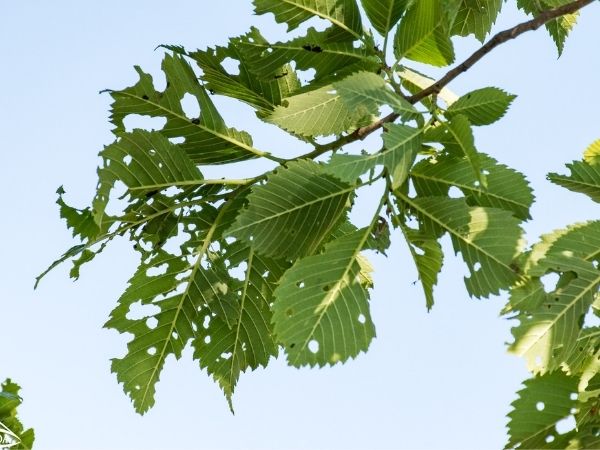How to Identify Spongy Moth
Insects go through metamorphosis (change in physical form) as they mature, and they often look different during each lifecycle stage. The spongy moth has four life stages: egg, caterpillar, pupa and moth.
In the spring, as trees begin to bud, egg masses, which look like puffs of brown fuzz, hatch into tiny caterpillars. These mature caterpillars are hairy and uniquely characterized by five pairs of blue dots and six pairs of red dots running along their backs. As the caterpillars grow, so does their appetite for leaves, which generally culminates during the months of May and June. After getting their fill, the caterpillars become pupae, which look like small, brown shells, emerging one to two weeks later as adult moths, usually in late June and early July.

The female moth is cream coloured and larger than the male moth, which is brown in colour. Only the male moths can fly. The female moths often remain on the tree they fed on when they were a caterpillar because their heavier, wider bodies make it difficult for them to fly. During the short two-week lifespan of the adult moths, they do not eat and only seek to reproduce and lay new egg masses for the next year.

Spongy Moth Damage
While spongy moth is a defoliating insect, damage only occurs for a short period of time during the caterpillar life stage. It tends to prefer oak, maple, elm, birch, poplar and willow trees, but isn’t too picky. During years when the spongy moth population spikes, damage may be severe. While defoliation is not ideal, most trees can withstand several years of severe defoliation before succumbing to a lack of resources. If the weather is favorable during those years, some trees may also put out a new set of leaves.
The greatest concern is that defoliation can make trees more susceptible to other stressors such as pest, extreme weather and disease. Urban trees are a special concern, because the urban environment is often more stressful for trees to begin with, due to factors such as soil compaction, limited space and vandalism. Because stress is compounded, reducing the impacts of the spongy moth is beneficial.

Five Ways to Minimize Spongy Moth Damage
- Be on alert for spongy moth news early in the year: many municipalities and local conservation authorities track and forecast spongy moth populations, which can help you prepare for the year ahead.
- Remove egg masses: from August until May, before hatching, egg masses can be scrapped off the tree and placed into a bucket of soapy water for one or two days, then disposed of in the garbage.
- Manage infestations carefully: an application of insecticide designed to control caterpillars may be appropriate for serious infestations, especially for larger trees; however, some product applications are time sensitive. For assessment and application, contact an ISA (International Society of Arboriculture) certified arborist.
- Remove caterpillars: from May onward, caterpillars can be handpicked and dumped into a bucket of soapy water for one to two days. Burlap band traps around the tree’s trunk can also help with collecting and disposing caterpillars.
- Take care of your tree so that it can take care of itself: regular water, organic compost and mulch helps reduce defoliation stress. For young trees, provide six gallons of water twice per week and for older trees water as needed from spring through fall.

Spongy moth populations are cyclical, so be sure to check for information and resources available through your municipality or local conservation authority. While defoliation cannot always be prevented, its impacts can be reduced, especially through actions such as regular care, which can help make your tree more resilient. For more information on spongy moth in your area, check out the following resources:
- York Region’s Spongy moth page
- City of Toronto’s LDD page
- Town of Newmarket’s LDD page
- City of Markham’s LDD page
- TRCA’s LDD page
- LSRCA’s Media Release page
- Ganaraska Region Conservation Authority's LDD factsheet
Jess Wilkin is the Residential Planting Programs Operations Supervisor.
LEAF offers a subsidized Backyard Tree Planting Program for private property. The program is supported by the City of Toronto, the Regional Municipality of York, the City of Markham, the Town of Newmarket, the Regional Municipality of Durham, the Town of Ajax, the City of Oshawa, the City of Pickering, the Township of Scugog, the Town of Whitby, Ontario Power Generation, Ontario Trillium Foundation and GrandTrees/Canadian Trees For Life.
